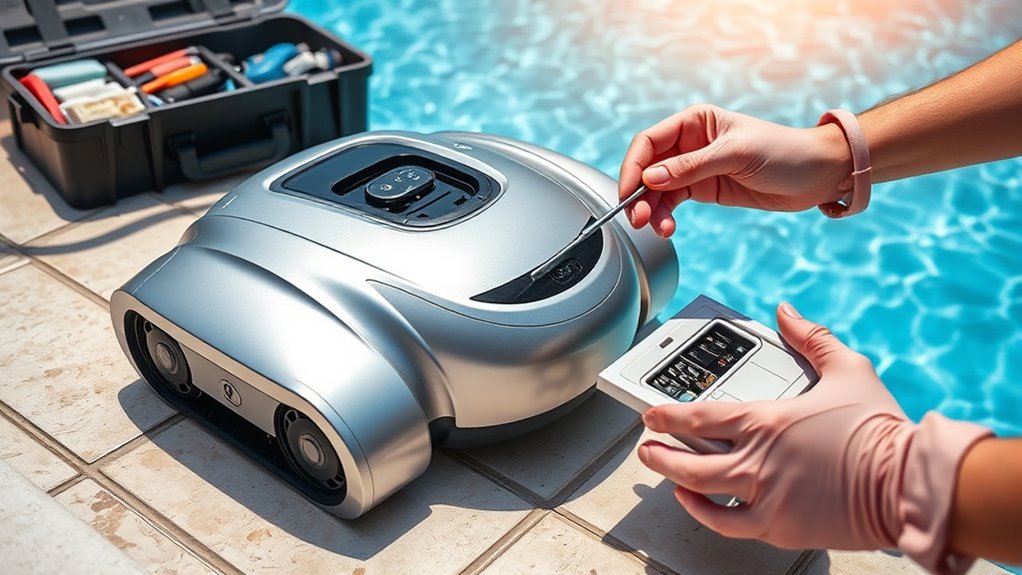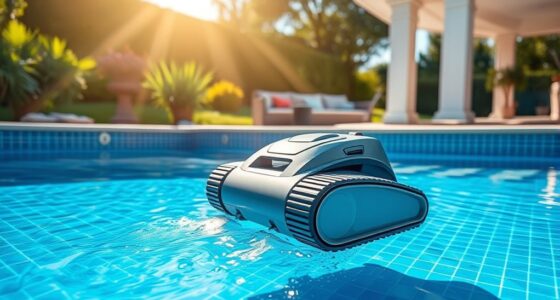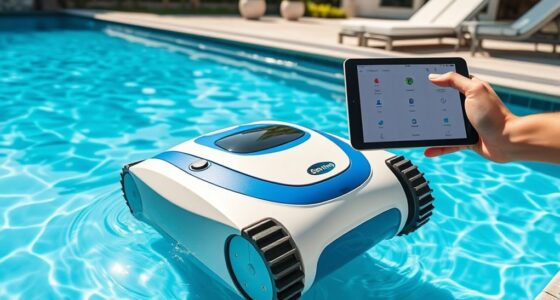You should service your robotic pool cleaner when you notice it’s missing spots, struggles with debris, or makes unusual noises. Regularly check filters, brushes, wheels, and electrical parts for wear or damage, and clean them thoroughly. Replace filters and brushes before they become worn out. Proper storage in a dry, cool place helps prolong its lifespan. Keep an eye on troubleshooting tips and maintenance routines to keep your cleaner running smoothly; more helpful advice awaits below.
Key Takeaways
- Service your cleaner regularly based on usage, inspecting brushes, filters, and electronic parts every 1-2 weeks.
- Replace worn brushes and filters promptly to prevent performance issues and extend device lifespan.
- Clean the device thoroughly before storage, ensuring it is dry and free of debris, especially after heavy use or chemical exposure.
- Store in a cool, dry, well-ventilated area away from direct sunlight and humidity to avoid damage.
- Seek professional help if persistent malfunctions, unusual noises, or error codes occur despite troubleshooting efforts.
Signs It’s Time for Servicing Your Pool Cleaner
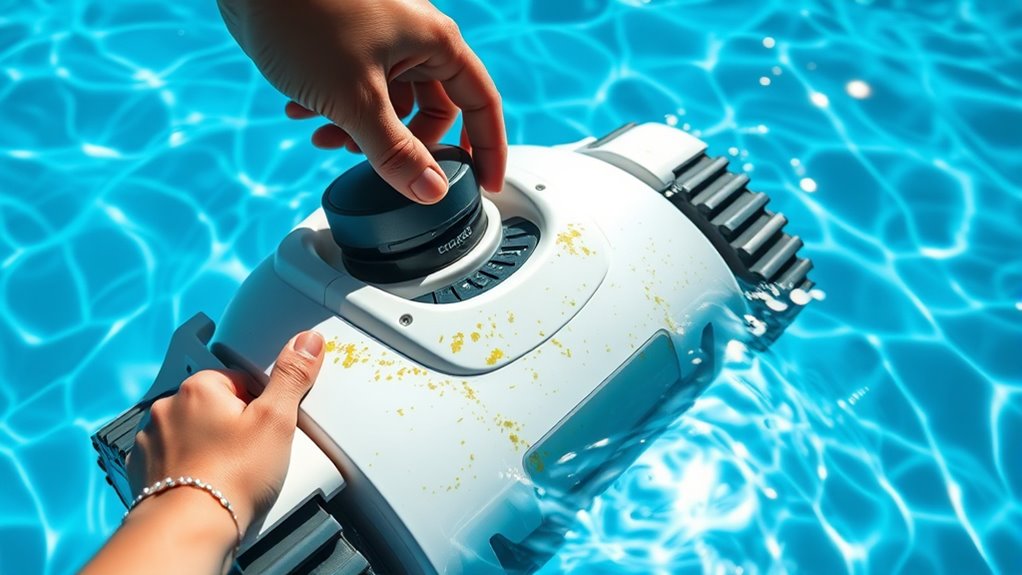
Wondering if your robotic pool cleaner needs maintenance? Changes in pool water chemistry can affect its performance, signaling it’s time for a check-up. If you notice the cleaner struggling to pick up debris or missing spots, it’s a sign something’s off. Different robotic pool cleaner models have specific needs, but common signs include unusual noises or decreased suction. Regular inspection of filter and brush performance can help identify issues early. Monitoring suction power and ensuring the brushes are free of debris can prevent more significant problems. Staying aware of automation technology advancements and model updates can help you better understand your device’s capabilities and maintenance needs. Watch for persistent algae or cloudy water, which might indicate the cleaner isn’t functioning properly. Also, if you see the device’s brushes or tracks aren’t moving smoothly, it’s a cue to inspect and service it. Staying alert to these signs ensures your cleaner stays in top shape, keeping your pool clean and well-maintained. Regular attention helps prevent bigger issues down the line.
Regular Maintenance Checks and When to Perform Them
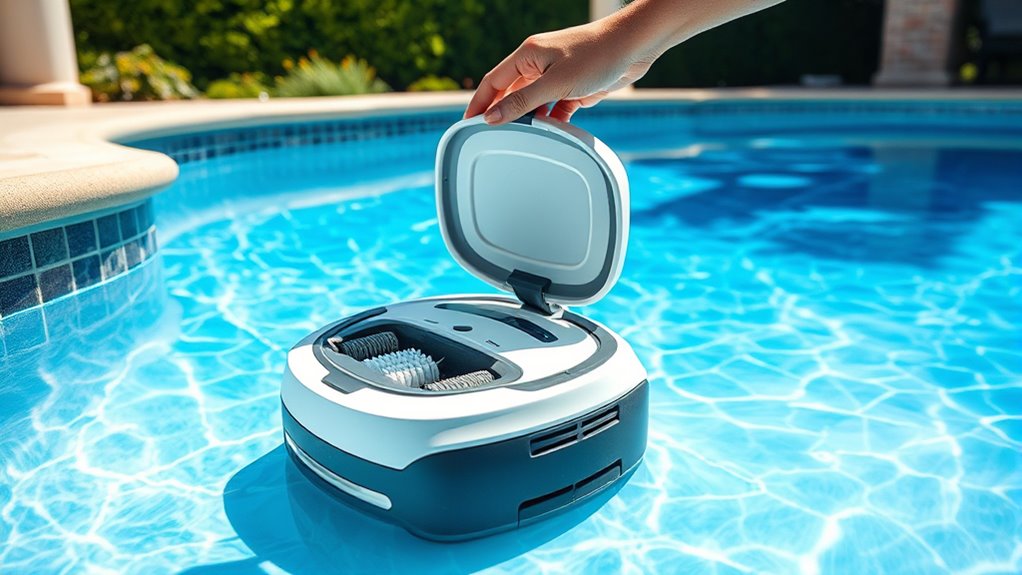
Performing regular maintenance checks on your robotic pool cleaner helps keep it running smoothly and prevents unexpected breakdowns. Establish a maintenance schedule based on how often you use your cleaner—weekly or biweekly checks are common. During these checks, inspect for loose wires, check the power supply, and ensure the unit’s wheels and tracks move freely. Regularly examine the brushes and filters for debris, even if you’re not cleaning or replacing them yet, to catch potential issues early. Keeping to a consistent maintenance schedule guarantees your robotic pool cleaner stays efficient and prolongs its lifespan. Additionally, understanding the sound vibrations involved in maintenance can help ensure your cleaner operates at optimal levels. Incorporating preventative maintenance techniques can further enhance the longevity and reliability of your device, which aligns with Chevrolet Tuning principles of optimizing performance through regular upkeep. Being aware of the component wear can also help you identify when parts need replacement before they cause larger problems. Regular inspections can also help detect any aluminum corrosion, which although less common, can affect the metal components over time if not addressed.
Cleaning and Replacing Filters and Brushes
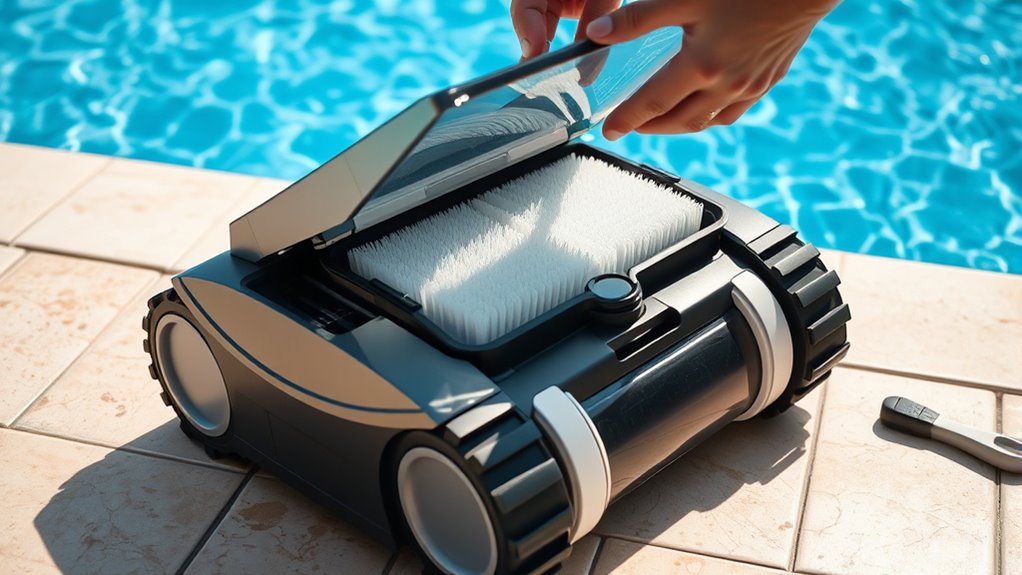
Regularly cleaning and replacing the filters and brushes on your robotic pool cleaner is essential for maintaining ideal performance. Proper filter replacement ensures debris doesn’t clog the system, while brush maintenance keeps the cleaner scrubbing effectively. Neglecting these tasks can reduce cleaning efficiency and strain the motor. To optimize your cleaner’s lifespan and performance, consider these points:
- Replace filters promptly when they become clogged or worn to maintain suction and filtration.
- Inspect brushes regularly for signs of wear and replace them to ensure effective scrubbing.
- Keep brushes clean from debris to prevent jams and ensure smooth operation.
- Using hydrocolloid technology in filters can enhance debris removal and promote quicker cleaning.
- Regular maintenance supports a healthier indoor environment by preventing the buildup of dirt and bacteria in your pool.
- Incorporating routine inspections can help identify issues early and prevent costly repairs, ensuring your cleaner operates at peak efficiency.
- Being aware of filter lifespan and replacing filters before they are excessively worn can further improve cleaning performance.
- Implementing preventative maintenance practices can extend the life of your robotic cleaner and avoid unexpected breakdowns.
Troubleshooting Common Issues During Servicing
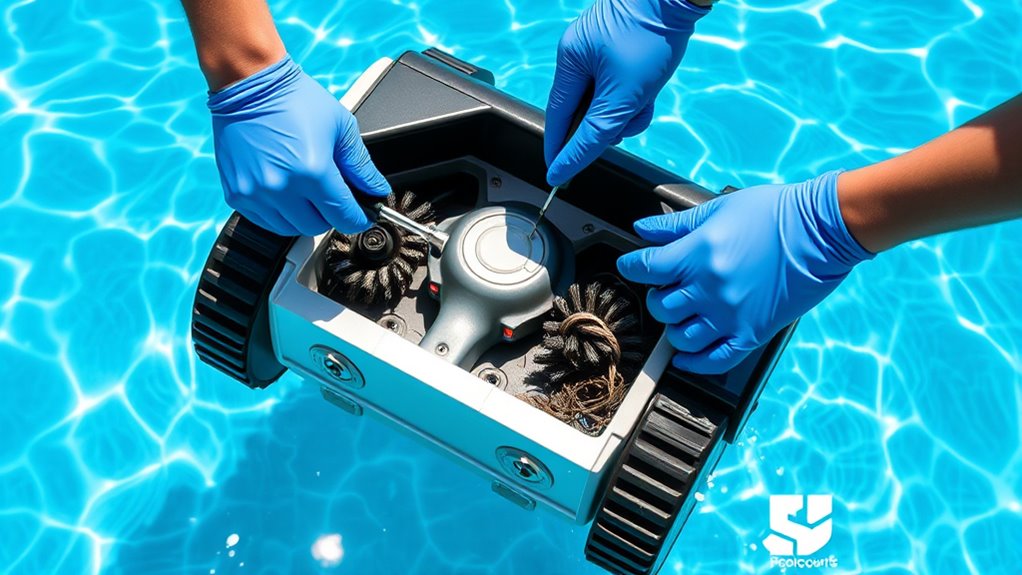
Even with careful maintenance, you may encounter common issues during servicing your robotic pool cleaner. Problems like poor cleaning performance, motor shutdowns, or cables tangling often stem from overlooked factors. Check the pool’s chemical balance; unbalanced chemicals can hinder the cleaner’s efficiency. Also, ensure your cleaner isn’t exposed to excessive sun, which can damage internal components. Regularly reviewing AI’s impact on automation can help you understand how technological advancements improve maintenance processes. Additionally, inspecting electric power generation components can help identify potential electrical issues that affect cleaner operation. Paying attention to Kia Tuning techniques can offer insights into how fine-tuning mechanical and electronic systems enhances overall performance. Proper calibration and performance optimization are essential for maintaining peak functionality of your robotic cleaner. Incorporating modern tuning methods can further extend the lifespan and reliability of your device.
Proper Storage and Preventive Care Throughout the Year
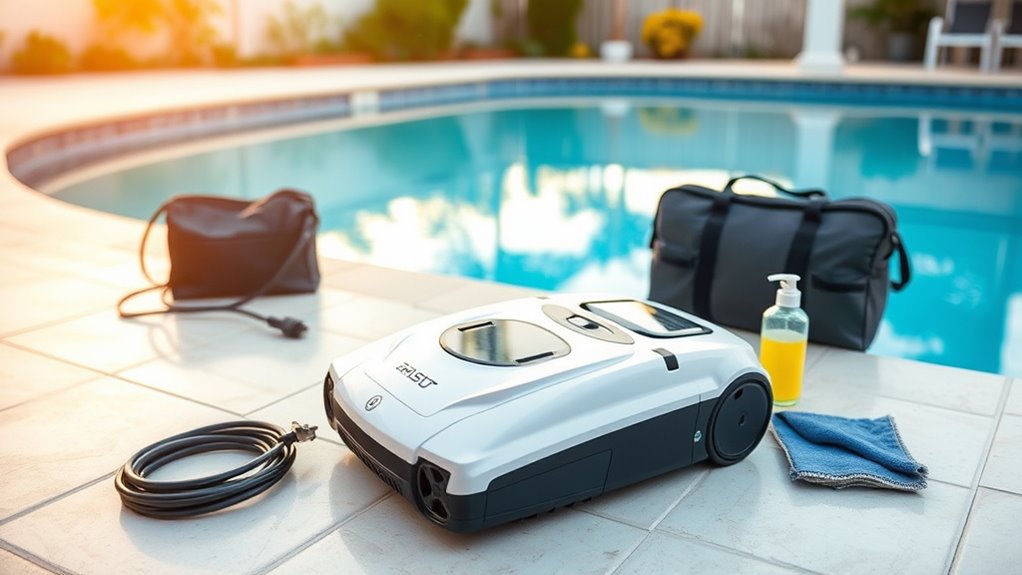
To maintain your robotic pool cleaner in top shape, proper storage and preventive care are essential. You should store it in a dry place, clean it thoroughly before putting it away, and perform regular maintenance checks. These simple steps will help extend its lifespan and ensure it works effectively year-round. Additionally, considering home security system options can provide peace of mind while you focus on maintenance. Regularly inspecting the water pressure and ensuring proper drainage can also help prevent issues caused by low water flow that might affect cleaning performance. Developing a resilience in facing challenges mindset can aid in troubleshooting and maintaining your equipment during unforeseen issues. For optimal operation, be sure to follow the manufacturer’s recommended service schedule to keep your cleaner functioning smoothly.
Store in a Dry Place
Storing your robotic pool cleaner in a dry place helps prevent damage caused by moisture and temperature fluctuations. Following proper storage guidelines guarantees your device stays in top condition year-round. Consider weather considerations like avoiding areas exposed to high humidity or direct sunlight, which can degrade components over time. When choosing a storage spot, keep these points in mind:
- Ensure the area is well-ventilated and moisture-free
- Avoid places prone to temperature extremes that could cause warping or cracking
- Use a protective cover or container to shield against dust and debris
Taking these steps helps maintain your cleaner’s longevity and performance. Proper storage not only protects your investment but also reduces the need for repairs, keeping your pool cleaner ready for use whenever you need it.
Clean Before Storage
Before you put your robotic pool cleaner away for the season, giving it a thorough cleaning is key to maintaining its performance. Removing dirt, debris, and any residual chemicals prevents buildup that can harm its components. Pay special attention to brushes, filters, and sensors, ensuring they’re free of obstructions. Proper cleaning enhances robotic cleaner longevity and helps prevent mold or corrosion during storage. Consider storage environment considerations—choose a cool, dry place away from direct sunlight and extreme temperatures. This prevents material degradation and preserves the device’s functionality. A clean, well-preserved robotic cleaner will be ready for supreme performance when pool season resumes, reducing the need for repairs and extending its lifespan. Proper cleaning before storage is a simple step with long-term benefits.
Regular Maintenance Checks
Regular maintenance checks are essential to keep your robotic pool cleaner in top condition throughout the year. Regularly inspect the device for debris and ensure the robotic arm is properly calibrated for peak cleaning efficiency. Maintaining balanced pool water chemistry prevents buildup that can hinder your cleaner’s performance and cause damage. During checks, verify that brushes and filters are clean and functioning correctly. Proper storage, such as keeping the cleaner in a dry, sheltered area, helps prevent unnecessary wear.
To maximize longevity, focus on these key areas:
- Keep pool water chemistry balanced to avoid corrosion or scale buildup
- Regularly calibrate the robotic arm for precise movement and cleaning
- Store the cleaner properly to prevent exposure to elements and damage
When to Seek Professional Assistance
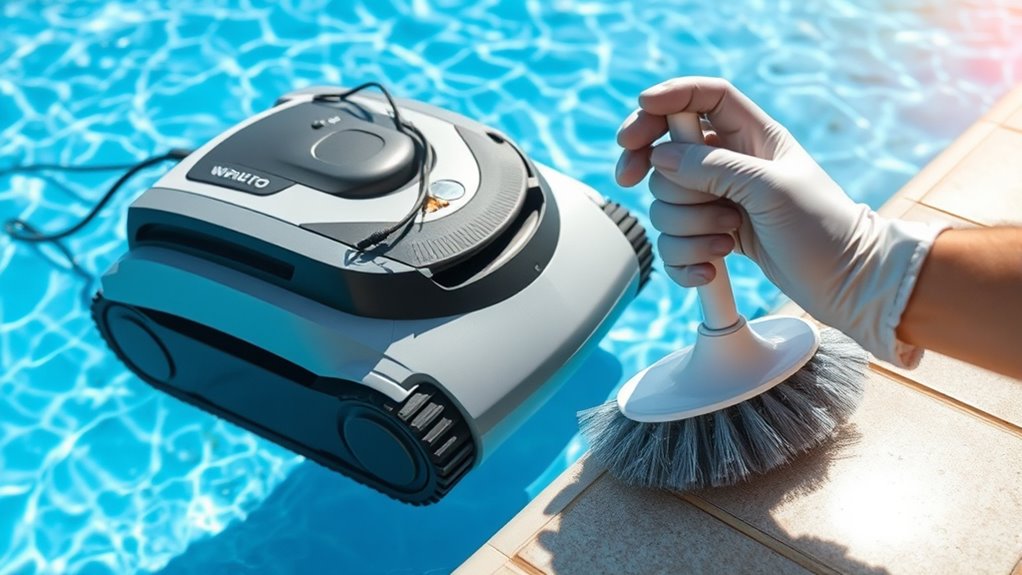
If your robotic pool cleaner keeps malfunctioning or shows error messages, it’s time to get professional help. Unusual noises or vibrations can also indicate a problem beyond simple troubleshooting. Don’t ignore these signs—they’re signals that expert repair may be necessary.
Persistent Malfunctions or Errors
When your robotic pool cleaner continues to malfunction despite troubleshooting, it’s a clear sign that professional help might be necessary. Persistent errors could stem from issues like misaligned robotic calibration or outdated software. If you’ve already checked the brushes, filters, and power connections, and the problem persists, it’s time to seek expert assistance. Professionals can:
- Perform precise robotic calibration to ensure proper navigation
- Update or reinstall software to fix bugs or compatibility issues
- Diagnose underlying hardware problems that aren’t repairable at home
Ignoring ongoing errors can lead to further damage or inefficient cleaning. Trusting professionals ensures your cleaner operates at peak performance, saving you time and frustration in the long run. Don’t hesitate to get expert help when persistent malfunctions continue.
Unusual Noises or Vibrations
Persistent malfunctions can indicate underlying mechanical issues that need professional attention. If your robotic pool cleaner starts making unusual noises or vibrating excessively, don’t overlook it. These sounds can signal electrical issues or worn components that require expert diagnosis. Sometimes, remote diagnostics can quickly identify the problem without extensive disassembly. If vibrations are persistent or noises become louder, it’s a sign you should seek professional help. Attempting to fix these problems yourself might worsen the damage or void your warranty. A trained technician can accurately pinpoint the source, whether it’s motor trouble, debris blockage, or electrical faults. Addressing these issues promptly ensures your cleaner remains effective and prevents costly repairs down the line.
Frequently Asked Questions
How Often Should I Schedule Professional Servicing for My Robotic Pool Cleaner?
You should schedule a professional inspection of your robotic pool cleaner at least once a year, depending on usage and water conditions. Following a proper maintenance schedule helps guarantee it operates efficiently. Regular checks, like cleaning brushes and filters, prevent buildup and damage. If you notice issues like decreased performance or strange noises, don’t wait—schedule a professional service promptly to keep your cleaner in top shape and extend its lifespan.
Can I Service My Robotic Cleaner Myself Without Voiding the Warranty?
You might worry DIY maintenance could void your warranty, but many robotic pool cleaners are designed for simple self-service. Check your user manual first; if it allows basic tasks like cleaning filters or inspecting brushes, you can do these yourself without risking warranty considerations. Just avoid disassembling major parts or using unapproved parts. Regular DIY maintenance keeps your cleaner in top shape while respecting warranty guidelines.
What Safety Precautions Should I Take During the Cleaning Process?
During cleaning, you should take safety precautions to avoid electric shock and chemical exposure. Always unplug the cleaner before starting, and keep electrical components dry. Wear gloves and goggles to protect against chemicals and debris. Avoid contact with the robot’s electrical parts if it’s wet, and make sure your hands are dry when handling it. Keep the area well-ventilated, and never operate the cleaner with damaged cords or parts.
Are There Specific Signs Indicating Motor or Electronic Component Failure?
Think of your robotic pool cleaner as a symphony orchestra; if one instrument falters, the harmony suffers. Signs of motor failure include unusual noises, sluggish movement, or the cleaner stopping unexpectedly. Electronic issues might cause the unit to restart repeatedly or display error codes. Keep an eye out for these signs, as they indicate something’s off with the motor or electronic components. Addressing these early keeps your cleaner performing at its best.
How Do Different Pool Types Affect Maintenance Routines for Robotic Cleaners?
Different pool types influence your maintenance routines because factors like pool surface and water chemistry vary. For example, a rough concrete surface may cause more wear on your robotic cleaner, while a vinyl surface might require less scrubbing. You should regularly check and adjust water chemistry to prevent buildup and corrosion, and clean your cleaner more often in saltwater pools to keep it functioning smoothly. Tailor your routine to your pool’s specific needs.
Conclusion
Regularly tending to your robotic pool cleaner keeps it running smoothly and extends its lifespan. By paying attention to subtle signs and performing routine care, you guarantee your pool stays crystal clear without unexpected hiccups. Think of it as giving your cleaner a gentle nudge in the right direction—small efforts now prevent bigger issues later. Keep up with maintenance, and your pool will thank you with effortless, sparkling cleanliness all season long.
